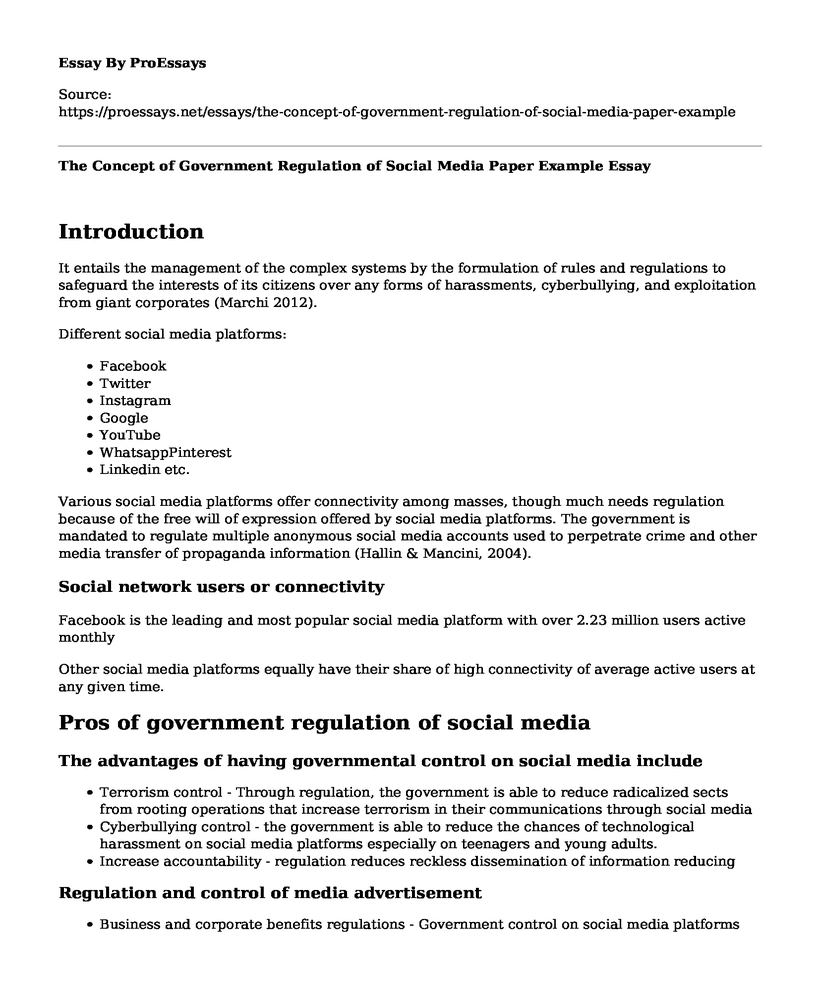Introduction
It entails the management of the complex systems by the formulation of rules and regulations to safeguard the interests of its citizens over any forms of harassments, cyberbullying, and exploitation from giant corporates (Marchi 2012).
Different social media platforms:
- YouTube
- WhatsappPinterest
- Linkedin etc.
Various social media platforms offer connectivity among masses, though much needs regulation because of the free will of expression offered by social media platforms. The government is mandated to regulate multiple anonymous social media accounts used to perpetrate crime and other media transfer of propaganda information (Hallin & Mancini, 2004).
Social network users or connectivity
Facebook is the leading and most popular social media platform with over 2.23 million users active monthly
Other social media platforms equally have their share of high connectivity of average active users at any given time.
Pros of government regulation of social media
The advantages of having governmental control on social media include
- Terrorism control - Through regulation, the government is able to reduce radicalized sects from rooting operations that increase terrorism in their communications through social media
- Cyberbullying control - the government is able to reduce the chances of technological harassment on social media platforms especially on teenagers and young adults.
- Increase accountability - regulation reduces reckless dissemination of information reducing
Regulation and control of media advertisement
- Business and corporate benefits regulations - Government control on social media platforms and companies help regulate users from oppressive giant corporates in different advertisement and other imposed charges among other exploitive strategies.
- Ban gun sale - when the government regulate the social media they are able to control illegal trade and malicious operations among gangs
- Social media giants control - It's the Congress and legislators' mandate to look out for the best interests for users on social media by regulating the corporate giant's rights and authorities over the users (McGivern & Fischer 2012).
Cons of governmental regulation of social media
The disadvantages of government regulation of social media include
Limitation of freedom of speech - The government is liable for overstepping the citizens' rights in some of their roles in the regulation of free speech and freedom of expression on social media platforms (Mendoza, 2014).
- Privacy violation
- Manipulation
- Extremism
- Accountability
Reasons for government regulation of censorship
According to Sjovaag (2014), the governments globally draws principals to act as guidelines for corporations and individuals to maintain self-regulation on media platforms to reduce cases of cyberbullying and other malpractices by drafting legislation to regulate social media use among masses. This is done through:
- Stipulation of rules
- Delegated legislation
- Enforcement of statutory instruments
- Legal restrictions
- Self-governance of organizations and individuals
Ways for regulation and censorship
The government should exercise full authority in ensuring that social media platforms and partnering bodies safeguard systems and legal restriction in the decency of interpersonal communication. Through a partnership with relevant stakeholders, the government systems will enforce strict conformity to regulate social media connectivity and interpersonal connectedness (Lowstedt & Al-Wahid, 2013). The different ways include
Promulgation of government authority
Contractual obligation of the:
- Insured
- Insurer
- Co-regulation
- Third party regulation
- Accreditation and certification
- Social platform monitoring
Efforts made to regulate social media publicity
Criminalities by increasing accountability, responsibilities, independence, and transparency in the dissemination of information as well as in the strategies to regulate free speech and reduction of harmful publicity (Krumsvik, 2011). These efforts have increased:
- Transparency
- Independence
- Accountability
- Responsibility
Successes in regulating social media fake news/publication
According to Lowstedt & Al-Wahid (2013), implementation of government policies to regulate statutory efforts in social media control have increased the accountability of users and corporate facilitators to reduce liability caused by reckless use of these platforms which include:
- Policy implications
- Liability
- Crackdown of perpetrators
References
Chapin, John (2016). "Adolescents and Cyber Bullying: The Precaution Adoption Process Model". Education and Information Technologies. 21 (4): 719-728. doi:10.1007/s10639-014-9349-1.
Hallin, D. & Mancini, P. (2004). Comparing Media Systems: Three Models of Media and Politics. Cambridgeshire: Cambridge University Press.
Krumsvik, Arne (2011). "Medienes privilegier - en innforing i mediepolitikk [Media Privileges: An Introduction to Media Politics]".
Lowstedt, Anthony & Al-Wahid, Sulaiman (2013). "Cultural diversity and the global regulation of new media technologies". International Journal of Media & Cultural Politics. 9: 195-200.
Marchi, R. (2012). "With Facebook, Blogs, and Fake News, Teens Reject Journalistic 'Objectivity'". Journal of Communication Inquiry. 36 (3): 246-62. doi:10.1177/0196859912458700.
Mendoza, Marcos Antonio "Reinsurance as Governance: Governmental Risk Management Pools as a Case Study in the Governance Role Played by Reinsurance Institutions", 21 Conn. Ins. L.J. 53, (2014) http://papers.ssrn.com/sol3/papers.cfm?abstract_id=2573253
McGivern, Gerry & Fischer, Michael Daniel (1 February 2012). "Reactivity and reactions to regulatory transparency in medicine, psychotherapy, and counseling" (PDF). Social Science & Medicine. 74 (3): 289-296. doi:10.1016/j.socscimed.2011.09.035. PMID 22104085.
Sjovaag, H. (2014). "the principles of regulation and the assumption of media effects". Journal of Media Business Studies: 5-20.
Cite this page
The Concept of Government Regulation of Social Media Paper Example. (2022, Sep 26). Retrieved from https://proessays.net/essays/the-concept-of-government-regulation-of-social-media-paper-example
If you are the original author of this essay and no longer wish to have it published on the ProEssays website, please click below to request its removal:
- Is the Hofstede Framework a Useful Aid in Understanding Cultures and Sub-cultures?
- Critical Essay on Orientalism by Edward Said
- Essay on Steubenville, Ohio Rape Case and the Media
- Presidential Space Policy Essay Example
- A Solitary Temple Amid Clearing Peaks Essay Example
- Supporting Affordable Housing and Section 8 Vouchers Paper Example
- Essay on Maria Rodriquez Reviving the Fashion Industry with Innovation and Experience







